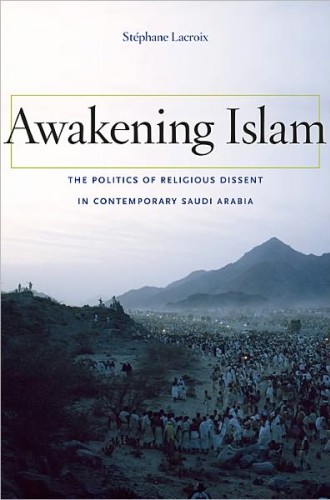Awakening Islam, by Stéphane Lacroix
Mention of Saudi Arabia conjures images of a fundamentalist kingdom where the government prohibits women from driving and forbids non-Muslims from holding religious services. The roots of the country's puritanical code go back several centuries. In 1744, an unwritten compact was made between a religious reformer and the Saudi chief of a small oasis settlement near the present-day Saudi capital of Riyadh. The reformer's name was Muhammad ibn Abd al-Wahhab. His Muslim adversaries dubbed his teachings Wahhabi, and the term stuck even though their adherents rejected it. For more than two centuries, Saudi rulers have backed Wahhabi doctrine, and Wahhabi clerics have blessed Saudi power.
Given the Saudi monarchy's commitment to upholding Wahhabi doctrine, specialists on Islam had a difficult time explaining the powerful religious protest movement that erupted in the early 1990s, in which protesters accused rulers of allowing infidels to undermine Islam. Were Wahhabi leaders turning against their historic patrons? Or were foreign Muslim ideologies at work?
Read our latest issue or browse back issues.
Stéphane Lacroix, a young French scholar, spent three years in Saudi Arabia investigating the roots of the protest movement. His prodigious research demonstrates that Saudi Arabia's native Wahhabi tradition had mixed with foreign Islamic revivalist ideas framed by the Muslim Brotherhood to produce a religious awakening known by the Arabic term sahwa. The conflict between the religious awakening and the Saudi-Wahhabi establishment turned on competing visions of what Islam requires of believers.
The father of Wahhabism believed that Muslims had lapsed into polytheism and that it was his mission to revive monotheism. He stirred controversy by attacking popular customs linked to holy men, claiming that any trace of veneration for them violated God's exclusive claim to worship and insisting that whoever refused to abandon and condemn such customs was a polytheist. Wahhabis regard Shi'ite Muslims as infidels because of their belief that their imams, descendants of the Prophet Muhammad through his son-in-law Ali, possess extraordinary spiritual powers. Likewise, Wahhabis disavow Sufis for their belief that holy men mediate between believers and God.
When it comes to politics, Wahhabi doctrine holds that as long as the ruler does not violate Islamic law, his subjects owe him loyalty and obedience. Religious leaders are not supposed to interfere in politics. If the ruler does wrong, they offer him advice in private because public criticism of the ruler undermines the unity of the believers, paving the way for social disorder and even anarchy, which must be avoided since there can be no implementation of Islamic law without an executive power.
Essentially, there is a division of authority between a monarch and religious clerics: the clerics lend legitimacy to the ruler, and the ruler enforces the clerics' definitions of rectitude. In modern Saudi Arabia, Wahhabi clerics have generally adhered to that bargain, wielding authority over Islamic law courts, education and public morality, as well as mosques and other religious institutions. They have left foreign relations, economic policy and domestic politics in the hands of the Saudi kings.
By contrast, the Muslim Brotherhood, a widespread revivalist movement founded in Egypt in the 1920s, espouses a vision of the good Islamic society that is based on both personal piety and public activism. It is less interested than Wahhabism in judging fellow Muslims on the basis of adherence to popular religious customs and more inclined to enter the political fray and dress down rulers for their shortcomings in defending Muslim interests. Awakening Islam is the story of how the Muslim Brotherhood became established in Saudi Arabia and mixed with the Wahhabi tradition to foster the sahwa—a hybrid form of revivalism.
Lacroix traces the awakening through five stages: inception, social activism, political protest, repression and a split into three tendencies. The awakening sprouted in the soil of regional Arab politics during the 1950s and 1960s, when secular regimes and conservative monarchies were at loggerheads, supporting subversive movements against each other and giving asylum to activists from rival countries. In Saudi Arabia members of the Muslim Brotherhood from Egypt and Syria found a favorable climate for their brand of religious politics. They circumvented the kingdom's ban on independent organizations by creating informal networks that recruited young Saudis through summer camps and sports clubs. The crisis over Iraq's 1990 invasion of Kuwait turned the awakening into a protest movement.
Days after the invasion, the Saudi king decided to accept the U.S. offer to defend the kingdom against possible attack, but he wanted the Wahhabi leadership's approval before proceeding. Senior clerics had to dance around the Islamic prohibition on seeking military assistance from infidels. They found a formula to endorse the decision by referring to "qualified" rather than "infidel" forces. As Western troops streamed into the kingdom, sahwa activists circulated cassette tapes of sermons condemning the betrayal of Islam. When a group of Saudi women took inspiration from female American soldiers who drove military vehicles to challenge the ban on women driving, activists felt certain that the real purpose of U.S. intervention was not to protect the kingdom but to undermine Islam. They responded with a vigorous political campaign against the American military presence. They also agitated for measures to buttress the kingdom's adherence to Islamic law and morality.
Saudi Arabia had never witnessed such widespread political mobilization, but the government handled the crisis, adopting a threefold approach to silence sahwa leaders. First, it reorganized Wahhabi institutions to strengthen direct royal control over key positions and root out sahwa sympathizers. Second, it encouraged loyal clerics to attack the religious credentials of the sahwa leaders. Third, it subjected sahwa leaders to pressure, banning them from preaching, then imposing a travel ban, and finally throwing them in prison in 1994. By the time the government released the sahwa leaders in 1999, it was coping with a growing militant movement inspired by Osama bin Laden.
The most prominent sahwa leaders sided with the Saudi rulers against al-Qaeda, as did the Wahhabi leadership, and dedicated themselves to combating Western influences in the kingdom without making political demands. Others adopted the cause of constitutional political reform. A small number drifted to more radical positions and threw in their lot with al-Qaeda, not only in its war against the United States but also in its terrorist attacks on Western targets in Saudi Arabia, which began in 2003.
Lacroix organizes his empirical findings according to a theoretical framework inspired by the French sociologist Pierre Bourdieu. Viewing culture as divided between religious and secular intellectual fields allows for subtle distinctions between subfields in Saudi Arabia's religious landscape. The general reader may find the argument difficult to grasp because Lacroix assumes some familiarity with Saudi Arabia and Islam, and the reader might get lost in the large cast of characters and the detailed analysis of their religious and political positions. But for the intended audience—specialists on Saudi Arabia and Islamic revivalist movements—Awakening Islam is bound to be the definitive account of how the Muslim Brotherhood took root in the kingdom and reshaped its religious landscape.






